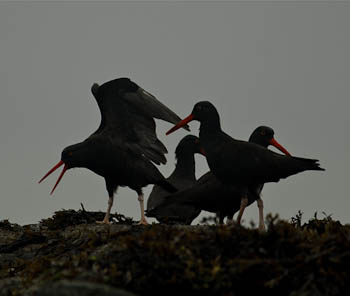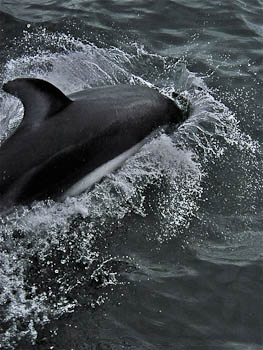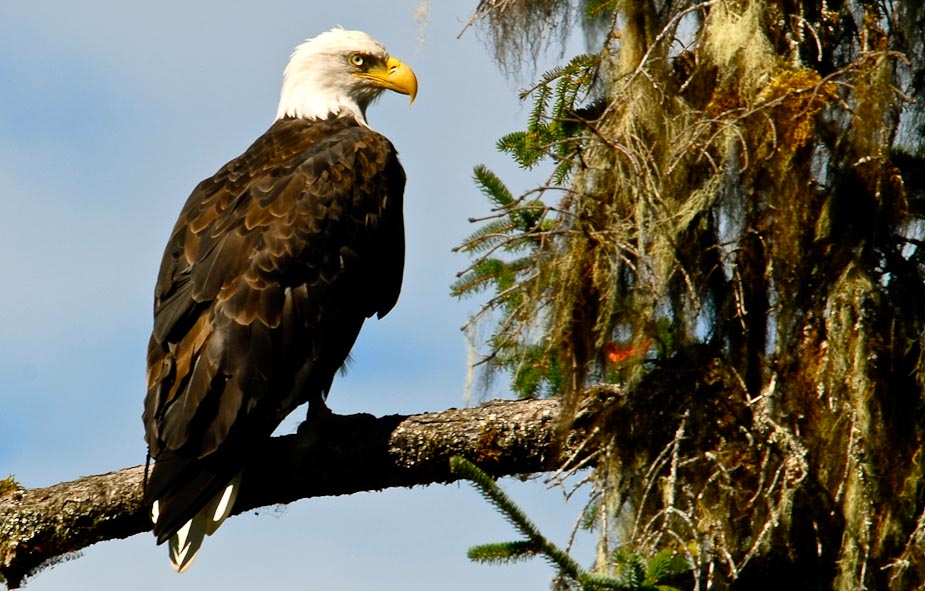II. CONSERVATION IN FOCUS:
THE SALISH SEA & SAN JUAN ISLANDS
October 2-9, 2011
Bob Rozinski & Wendy Shattil, Jennifer Hahn,
Bill & Shannon Bailey, and M/V Catalyst Crew
 Thousands of years before the arrival of European
settlers in the Pacific Northwest, the Coastal
Salish flourished along the shores of one of the
most biologically rich inland seas in the world.
The Salish Sea, named in honor of those first
inhabitants, straddles the Canadian border and
includes Washington’s Puget Sound, the Strait of
Juan de Fuca and the San Juan Archipelago, and
British Columbia’s Gulf Islands and the Strait of
Georgia. Connected to the Pacific Ocean primarily
via the Strait of Juan de Fuca, the 17,000-
square-kilometer Salish Sea receives an almost
constant influx of nutrient-rich freshwater from
British Columbia’s Fraser River, the Skagit, and
the many smaller rivers of Washington’s mainland—-
the essential building blocks for the sea’s
extraordinary biodiversity. The strong currents
and extreme tidal exchanges that characterize the
Salish Sea create optimal conditions for nutrient
upwelling and for the proliferation of the photosynthetic
plankton that forms the base of the
marine food chain. Over 7 million people live
within the drainage basin that nourishes the Salish
Sea, including the cities of Seattle, Vancouver,
Victoria, Nanaimo, Bellingham, Port Townsend,
and Tacoma—-a reality that poses a significant
environmental challenge now and in the future. Thousands of years before the arrival of European
settlers in the Pacific Northwest, the Coastal
Salish flourished along the shores of one of the
most biologically rich inland seas in the world.
The Salish Sea, named in honor of those first
inhabitants, straddles the Canadian border and
includes Washington’s Puget Sound, the Strait of
Juan de Fuca and the San Juan Archipelago, and
British Columbia’s Gulf Islands and the Strait of
Georgia. Connected to the Pacific Ocean primarily
via the Strait of Juan de Fuca, the 17,000-
square-kilometer Salish Sea receives an almost
constant influx of nutrient-rich freshwater from
British Columbia’s Fraser River, the Skagit, and
the many smaller rivers of Washington’s mainland—-
the essential building blocks for the sea’s
extraordinary biodiversity. The strong currents
and extreme tidal exchanges that characterize the
Salish Sea create optimal conditions for nutrient
upwelling and for the proliferation of the photosynthetic
plankton that forms the base of the
marine food chain. Over 7 million people live
within the drainage basin that nourishes the Salish
Sea, including the cities of Seattle, Vancouver,
Victoria, Nanaimo, Bellingham, Port Townsend,
and Tacoma—-a reality that poses a significant
environmental challenge now and in the future.
 The San Juan Archipelago lies at the heart of the
Salish Sea and provides the perfect setting for our
second "Conservation in Focus" workshop. Life
in the San Juan Islands is governed by the sea’s
rhythms—-and we turn our attention to navigating
a watery maze of channels, passes, and reaches
aboard the M/V Catalyst, a 76-foot classic wooden
boat originally built in 1932 as the floating
laboratory for the University of Washington.
Today, with owners and naturalists Bill and
Shannon Bailey at the helm, Pacific Catalyst
carries on the conservation tradition. The ultimate
"classroom" afloat, Catalyst carries 12 passengers
in superb comfort and is equipped with a full
complement of sea kayaks and a motorized inflatable
to enable explorations both near and far. The
use of sea kayaks allows a more intimate, seal’s-eye
view of the marine world—-the perfect platform
for aspiring conservation photographers.
Our Conservation in Focus leaders include the
renowned nature photographers Wendy Shattil
and Bob Rozinski, and naturalist co-leader Jenny
Hahn, one of the Northwest’s foremost guides and
an award-winning author. The San Juan Archipelago lies at the heart of the
Salish Sea and provides the perfect setting for our
second "Conservation in Focus" workshop. Life
in the San Juan Islands is governed by the sea’s
rhythms—-and we turn our attention to navigating
a watery maze of channels, passes, and reaches
aboard the M/V Catalyst, a 76-foot classic wooden
boat originally built in 1932 as the floating
laboratory for the University of Washington.
Today, with owners and naturalists Bill and
Shannon Bailey at the helm, Pacific Catalyst
carries on the conservation tradition. The ultimate
"classroom" afloat, Catalyst carries 12 passengers
in superb comfort and is equipped with a full
complement of sea kayaks and a motorized inflatable
to enable explorations both near and far. The
use of sea kayaks allows a more intimate, seal’s-eye
view of the marine world—-the perfect platform
for aspiring conservation photographers.
Our Conservation in Focus leaders include the
renowned nature photographers Wendy Shattil
and Bob Rozinski, and naturalist co-leader Jenny
Hahn, one of the Northwest’s foremost guides and
an award-winning author.
The key to the biological richness of the San Juan
Archipelago lies in the diversity of terrestrial and
marine habitats available to plants and animals--evergreen forests, grasslands, salt marshes, embayments,
estuaries, beaches, rocky shorelines,
and deepwater fjords. In fact, these productive
marine waters are home to several "giants" of the
marine world—-the North Pacific giant octopus,
the plumose anemone, giant red sea urchin, and
the geoduck, largest of the burrowing clams. The
Salish Sea is home to all five species of Pacific
salmon, as well as sea-run steelhead and bull
trout. It also provides critical habitat for marine
mammals such as migrating grey whales, resident
and transient populations of killer whales, harbor
seals, Steller and California sea lions, and river
otters. At least 165 species of birds depend on the
Salish Sea and its adjacent terrestrial habitats for
survival.  The San Juan Islands lie within the rain
shadow of the Olympic Mountains, which results
in a greater diversity of terrestrial habitats than is
typical of many wetter mainland areas. The seabirds
and shorebirds we’ll see include murrelets,
guillemots, murres, auklets, scoters, grebes,
oystercatchers, and sandpipers. Many will have
just arrived from breeding areas in more northerly
Pacific waters. All seabirds live at the mercy of
wind and wave. As the sea goes—storm-ridden or
serene—-so must they. So it goes, too, for the
entire Salish Sea realm—-in all its beautiful
complexity. We now know that the survival of this
unique ecosystem is intimately tied to the
ecological health of the sea as well as to that of
the land—making the entire web of life especially
vulnerable to the impacts of global warming,
marine pollution, diminished food resources, fish
farming practices, commercial fishing and seabird
by-catch, logging, and human populations. The San Juan Islands lie within the rain
shadow of the Olympic Mountains, which results
in a greater diversity of terrestrial habitats than is
typical of many wetter mainland areas. The seabirds
and shorebirds we’ll see include murrelets,
guillemots, murres, auklets, scoters, grebes,
oystercatchers, and sandpipers. Many will have
just arrived from breeding areas in more northerly
Pacific waters. All seabirds live at the mercy of
wind and wave. As the sea goes—storm-ridden or
serene—-so must they. So it goes, too, for the
entire Salish Sea realm—-in all its beautiful
complexity. We now know that the survival of this
unique ecosystem is intimately tied to the
ecological health of the sea as well as to that of
the land—making the entire web of life especially
vulnerable to the impacts of global warming,
marine pollution, diminished food resources, fish
farming practices, commercial fishing and seabird
by-catch, logging, and human populations.
Delivering a strong conservation message with
your images requires a thorough understanding of
your subject—-as well as a sense of the importance
of photographic integrity and ecological
stewardship. As an integral part of this workshop,
we’ll create a custom photo book that captures the
essence of the Salish Sea-—as well as the environmental
challenges that loom on the horizon.
Don’t miss this opportunity to refine your photographic
skills, to be inspired, and to learn how to
make a conservation difference with your images!
Price: $2,450 (includes a $500 deposit)
Group Size: 12
Trip Rating: 2-3
Price Includes:
5 nights/6 days aboard the M/V
Catalyst, all meals and beverages (including wine
and beer), 2 night’s lodging (October 2 & 8 in
Friday Harbor on San Juan Island), two group
dinners ashore, all instruction by our photographic
and naturalist leaders, full sea kayak outfitting,
Catalyst’s four-person crew and all gratuities, a
copy of our group-produced photo book, and a
copy of Jenny’s Pacific Feast. The price quoted is
per person based on double occupancy. The
Catalyst has only one single berth cabin. A single
supplement of $950 is required of any participant
preferring non-shared boat accommodations or for
whom we have no roommate available. Does not
include roundtrip airfare or travel from your point
of departure to Friday Harbor, San Juan Island.
Seminar begins with dinner and lodging in Friday
Harbor on October 2 and concludes with dinner
and lodging on October 8.
Need more information? Visit the Pacific
Catalyst website at www.pacificcatalyst.com for
boat pictures, cabin details, interior spaces and
amenities, and biographies of the crew.
|
